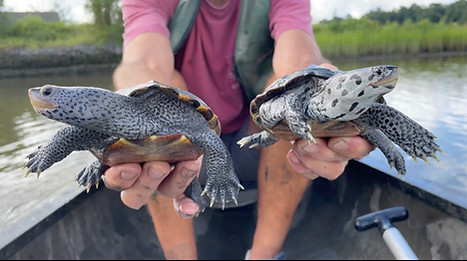top of page
The Diamondback Terrapin
About the Terrapin
The diamondback terrapin (malaclemys terrapin) is a small, estuarine turtle - the only exclusively brackish water turtle in North America. Terrapins live in saltmarshes and seagrass beds, all along the East Coast from New England to Texas, and even on the island of Bermuda. There are seven diamondback terrapin subspecies within this range.

Life Cycle
Dr. Randy Chambers of William & Mary holds two adult terrapins
Terrapin eggs are laid in early spring in nests dug by female terrapins on land. Young terrapins typically hatch within three months, generally in early autumn. Sometimes, the hatchlings remain in the nest throughout the fall and winter, only emerging the next spring. Terrapin nests are vulnerable to predation by raccoons, crows, and other scavenging predators.
Terrapins exhibit clear sexual size dimorphism, as adult female terrapins are much larger than adult male terrapins. Female terrapins reach maturity between six and eight years, while males reach maturity around four years of age. Like many turtles, terrapins brumate (or hibernate) during the winter, burying themselves in the mud and only surfacing occasionally.
Conservation Threats
The word terrapin comes from the Algonquin word torope, which means turtle. While terrapins were traditionally eaten by Native Americans, they were hunted much more extensively in the late 1800's-early 1900's for consumption in a dish called turtle soup. The dish was so popular that it was included in President Grover Cleveland's The White House Cookbook in the early 1890's as "Stewed Terrapin with Cream", and the demand for turtle soup drove the terrapin to local extinction in some areas along the Eastern Seaboard. However, a main component of turtle soup was sherry, and the start of Prohibition caused demand for turtle soup to plummet. Luckily, terrapin populations were given a chance to recover, and terrapin soup never made a comeback.
Today, terrapins face more modern threats. Habitat loss and road traffic are large contributors to turtle mortality. Although most states have outlawed terrapin harvest, terrapins frequently drown in commercial-style blue crab traps in areas without bycatch reduction device requirements. You can read more about this and other conservation issues on our Conservation Stories page.

A terrapin hatchling emerges

A researcher holds a large adult female terrapin

This abandoned crab pot contained 94 dead terrapins
bottom of page
